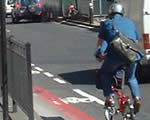 Go to main content
Go to main content
Archive Website of the UK government
Please note that this website has a UK government accesskeys system.
Main menu
Page menu
Travel and transport

Where you can use your bike

You can cycle on most roads but a cycle route can help you identify the cycle lanes and quiet roads most suitable for cyclists. You can also cycle in the countryside on certain off-road paths, like bridleways. Get advice on where you can cycle and how to find a route.
Check the Highway Code
Routes for cyclists

This sign shows a route recommended for cyclists
You can ride your bike on most roads and:
- cycle lanes (on the road)
- cycle tracks and bridleways (found away from the road)
- bus lanes – if there’s a sign saying sign saying cyclists can use them
However, you must not ride, for example:
- on the pavement – unless signs show that cyclists are allowed to cycle on it
- through red lights
- the wrong way down a one-way street – unless signs say that cyclists can do otherwise
- across a pelican, puffin or zebra crossing – but you can cycle across a toucan crossing when the green light for cyclists shows
- on motorways
- where you see a 'no cycling' sign
These rules are set out in the Highway Code – many of the rules are legal requirements. If you disobey these rules, you are committing a criminal offence.
Finding a cycle route
Cycle routes give directions for where you can ride your bike on roads or parts of roads that are suitable for cyclists. They are usually made up of a combination of quiet roads, cycle lanes and off-road facilities, like crossings. Cycle routes may also show where you’ll need to get off your bike to cross a particularly busy road or roundabout.
Many local cycle lanes and routes are part of local cycle networks or the National Cycle Network. You can get a map of the National Cycle Network from the charity Sustrans. The network is made up of more than 12,000 miles of on-road cycling routes, traffic-free paths and quiet lanes.
Local cycle routes
Contact your local council for information about cycle routes in your area.
You can use the Cross & Stitch cycle planner to plan a cycling route in certain areas. You can also make suggestions for improvements to the routes or the tool.
Cycle routes for London
You can search for cycle routes in London using the Transport for London (TfL) journey planner. You can also order free cycle guides and find out about the cycle hire scheme and London’s cycling superhighways.
The London Cycling Campaign (LCC) also has a London-wide cycle route library.
Cycling in the countryside
You can cycle in the countryside on public roads, designated cycle paths and cycle tracks. Traffic signs will show which paths are available for cyclists. You can also use bridleways, but you must give way to horse riders and walkers. For more information on bridleways and how to find them, see 'Public rights of way'.
To find a cycle trail in a forest or wood, use the tool on the Forestry Commission website.
Cycling along canal towpaths
If you plan to cycle along a canal towpath, check whether you need to display a permit on your bike. You can find out which canals you’ll need a free permit for and download a permit from the British Waterways Waterscape website.
To cycle on London's towpaths, you don’t need a permit but you must follow London's towpath code of conduct.
Taking your bike on public transport
If you want to take your bike on a bus or coach, check with the operator. You may need to dismantle your bike and put it in a cover.
If you're travelling by train with your bike, check with the train company before you buy your ticket.
Folding bikes on trains
You can travel with your folding bike without restriction on all services. You may need to cover it on some services.
Standard bikes on trains
Many train companies don't allow you to travel with a standard bike at peak times. Peak times are generally 7.00 am to 10.00 am and 4.00 pm to 7.00 pm. You may need to make a reservation for your bike on some routes.
For detailed advice for each train service and links to contact details for train companies, see the National Rail Enquiries website.
Travelling with a bike in London
For advice about when you can travel on London buses, trains or the tube, check the Transport for London (TfL) website.
Cycle lanes and cycle parking
Your local council is responsible for providing and maintaining cycle lanes and infrastructure, like cycle stands and signage, in your local area. Contact your council if you want information about existing and planned cycle lanes or stands in your area.
More useful links
In this section...
Additional links
THINK! road safety advice

Find out how to stay safe on the roads with THINK! facts and stats, adverts and games
Simpler, Clearer, Faster

From 17 October, GOV.UK will be the best place to find government services and information
 Facebook
Facebook Twitter
Twitter StumbleUpon
StumbleUpon Delicious
Delicious Reddit
Reddit